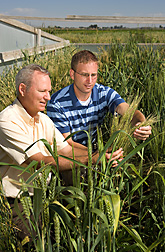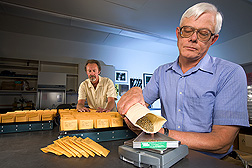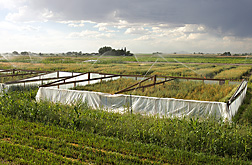RUSTPROOF! Idaho Experts
Search for Stem-Rust-Resistant Wheat
|
|
Somewhere, village farmers might still grow traditional wheats that could hold the remedy for stem rust. Killer races of that plant disease newly threaten wheat around the world.
The traditional, locally grown wheats may just happen to have genes that could fend off rusts now emerging in east Africa. That’s according to plant pathologist J. Michael Bonman, who leads the ARS Small Grains and Potato Germplasm Research Unit at Aberdeen, Idaho.
Scientists refer to these local wheats as “landraces.” These plants are targets of the Idaho team’s fast-paced, high-intensity search for untapped sources of stem-rust resistance.
That’s the case even though local wheats have their share of drawbacks. “They tend to be too tall for what we need in modern agriculture,” says Bonman. And though they’re well adapted to certain regions, local wheats are generally unadapted to the soils and climates of America’s major wheat-growing ecosystems, he says.
But local wheats are, in general, easier to work with than wild wheats. Notes Bonman, “If you crossbreed, or hybridize, a local wheat with a commercial wheat, you’ll be closer to getting a market-ready wheat than if you started by crossing a wild wheat with that same commercial wheat.”
Bonman and others are confident that local wheats warrant careful attention as potential reservoirs of rust-resistance genes that could rescue other wheats from the threat of this formidable fungal disease. And thanks to years of work by generations of plant explorers, breeders, and others, seeds of 25,000 different kinds of local wheats are already at hand in Aberdeen. They’re among the nearly 60,000 wheat types stored there. The collection serves as America’s official genebank of wheat—and wheat relatives like emmer and spelt—from around the planet. Curator and agronomist Harold E. Bockelman manages this treasure trove of wheat seeds and plants.
The Collection: Is an Answer Hidden Within?
To learn more about the rust resistance of the genebank’s local wheats, Bonman and colleagues combed decades-old records of the disease-fighting prowess of nearly 8,500 specimens. Plant pathologist Don V. McVey, now retired from ARS’s Cereal Disease Laboratory in St. Paul, Minnesota, created those records when he tested the plants, beginning in 1988.
Though McVey couldn’t have exposed the plants to the new races now damaging wheatfields of east Africa (see story, “World Wheat Supply Threatened” in this issue), his test results are nonetheless relevant and are an important starting point, says Bonman.
The new analyses of McVey’s findings revealed notable resistance in wheats from several places, including Chile, Ethiopia, Turkey, and Bosnia and Herzegovina. “We need to intensify our analyses of genebank landraces that originated from these areas,” says Bonman.
In related work, Bonman and coinvestigators used a computerized, math-based model to evaluate 10 telling traits of nearly 3,000 local wheats. Those traits included resistance to stem rust relatives, such as stripe rust and bunt, and the ability to fend off attack by a devastating insect foe, the Hessian fly.
The analysis pinpointed more than 200 wheats that had “anywhere from a 50-percent to a 70-percent probability of being resistant to stem rust,” says Bonman. He did the work with Bockelman and with ARS plant pathologist Yue Jin of the St. Paul lab; mathematician Ann Inez Gironella, Idaho State University-Pocatello; and Geographic Information Systems researcher Robert J. Hijmans at the International Rice Research Institute, Manila, Philippines. They documented their results in a recent issue of Crop Science.
|
|
Wanted: Survivors
The new geographical data and data from the model help the scientists choose wheats to ship from Aberdeen to Africa. There, special research nurseries—in Kenya and, more recently, Ethiopia—operate in the heart of the rust epidemic.
But not all seeds will make the trip. “There isn’t enough space in the nurseries to test all our landraces at once,” says Bockelman.
For the tests, Aberdeen plant pathologist Blair J. Goates has solicited seeds from dozens of companies and university and government plant breeders throughout the United States. It’s one way to ensure that the best of their best, along with promising landraces from the Aberdeen genebank, are among those considered for a coveted planting space abroad. Goates is doing the work with members of U.S. committees organized to create superior wheats and barleys for future use.
Once the tough choices are made, Goates makes certain the selected seeds are free of insect pests and diseases before they are shipped.
The Kenyan nursery is now in its third year. The Ethiopian research plots were planted for the first time this spring. Both are managed by the International Maize and Wheat Improvement Center, or CIMMYT, and Ethiopian and Kenyan collaborators. Already the nursery studies are yielding timely, reliable results about rust resistance.
These findings should benefit not only wheat, but also several other kinds of grain-bearing plants growing in the nurseries—all likely to be vulnerable to the new stem rusts. Among them are barley and triticale, a wheat-and-rye hybrid. Like the wheats, some of these other grains are from the Aberdeen genebank.
ARS’s involvement in foreign nurseries situated where a plant disease is at its worst has already proven its worth in other preparedness projects. In the early 1990s, for instance, ARS agronomist Darrell M. Wesenberg, now retired from Aberdeen, helped orchestrate tests of genebank barleys in fields near Cochabamba, Bolivia. A fungus that causes barley stripe rust was out of control there.
The upstart rust eventually invaded the United States. But thanks to the Bolivia research and to parent plants conserved at Aberdeen, Wesenberg and Colorado coinvestigators were able to offer barley breeders and seed producers a new, stripe-rust-resistant barley called “Bancroft.”
Partial Resistance: Best Bet?
Now Aberdeen scientists are augmenting the overseas tests with additional experiments closer to home. Molecular biologist Eric W. Jackson is putting some promising traditional wheats through their paces to see how plants react to Idaho races of stem rust.
Jackson hopes to pinpoint resilient plants that can tolerate a low level of infection. Though infected and colonized by the rust microbe, the ideal plants “wouldn’t have any economic damage,” he says.
It’s a “live and let live” strategy that Jackson says may offer a longer lasting solution than absolute resistance.
“If you go with complete resistance,” he explains, “you’re putting selection pressure—survival of the fittest—on the rust fungus. You’re forcing it to evolve so that it can overcome the plants’ resistance. This pressure means you may end up with a more virulent strain of rust than you had in the first place.”
Partial resistance may be the work of several genes, not just one, he notes. That could further broaden and deepen this ecofriendly defense.
Seeds from the Aberdeen collection are commanding a starring role in Jackson’s tests, just as they are doing in the faraway fields of Africa. Rich and diverse, the collection offers new hope of protecting the world’s amber waves of grain.—By Marcia Wood, Agricultural Research Service Information Staff.
This research is part of Plant Genetic Resources, Genomics, and Genetic Improvement, an ARS national program (#301) described on the World Wide Web at www.nps.ars.usda.gov.
J. Michael Bonman, Harold E. Bockelman, Blair J. Goates, and Eric W. Jackson are in the USDA-ARS Small Grains and Potato Germplasm Research Unit, 1691 S., 2700 W., Aberdeen, ID 83210; phone (208) 397-4162, fax (208) 397-4165.
"RUSTPROOF! Idaho Experts Search for Stem-Rust-Resistant Wheat" was published in the November/December 2007 issue of Agricultural Research magazine.









